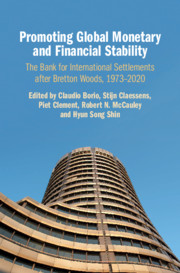 Promoting Global Monetary and Financial Stability
Promoting Global Monetary and Financial Stability Book contents
- Promoting Global Monetary and Financial Stability
- Studies in Macroeconomic History
- Promoting Global Monetary and Financial Stability
- Copyright page
- Contents
- Graphs and Tables
- Contributors
- Foreword
- Acknowledgements
- Abbreviations
- Introduction
- 1 The BIS and the European Monetary Experiment
- 2 The Governance of the Bank for International Settlements, 1973–2020
- The BIS in Pictures, 1973–2020
- 3 A Theory of Everything
- 4 Tower of Contrarian Thinking
- 5 Exchange Rates, Capital Flows and the Financial Cycle
- 6 The Bank for International Settlements
- Book part
- Note on Sources
- Bibliography
- Index
- Other Books in the Series (Continued from p. ii)
1 - The BIS and the European Monetary Experiment
Published online by Cambridge University Press: 10 April 2020
- Promoting Global Monetary and Financial Stability
- Studies in Macroeconomic History
- Promoting Global Monetary and Financial Stability
- Copyright page
- Contents
- Graphs and Tables
- Contributors
- Foreword
- Acknowledgements
- Abbreviations
- Introduction
- 1 The BIS and the European Monetary Experiment
- 2 The Governance of the Bank for International Settlements, 1973–2020
- The BIS in Pictures, 1973–2020
- 3 A Theory of Everything
- 4 Tower of Contrarian Thinking
- 5 Exchange Rates, Capital Flows and the Financial Cycle
- 6 The Bank for International Settlements
- Book part
- Note on Sources
- Bibliography
- Index
- Other Books in the Series (Continued from p. ii)
Summary
This chapter traces the origins of the European monetary unification project. The 1957 Treaty of Rome called for monetary policy coordination within the EEC. To achieve this, a committee of governors of the EEC central banks was created (1964). The governors chose the BIS in Basel as their meeting place to underline their independence from the EEC in Brussels. In the 1970s, after the breakdown of the Bretton Woods system of fixed exchange rates, the committee played a key role in the attempts to restore stable exchange rates within Europe, leading to the creation of the European Monetary System (EMS). In 1988–9, the BIS hosted the Delors Committee for the study of monetary union in Europe. The conclusions of the Delors Committee provided the basis of the 1992 Maastricht Treaty, which set the EU on the path of monetary union. Once this decision had been taken, the role of the BIS as host and agent of the EMS came to an end, and the committee of governors – soon recreated as the European Monetary Institute (EMI) and then European Central Bank (ECB) – moved from Basel to Frankfurt. The chapter ends with an assessment of the euro crisis of 2011–12.
Keywords
- Type
- Chapter
- Information
- Promoting Global Monetary and Financial StabilityThe Bank for International Settlements after Bretton Woods, 1973–2020, pp. 11 - 45Publisher: Cambridge University PressPrint publication year: 2020
